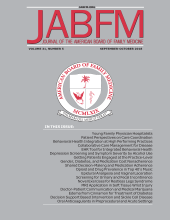Abstract
Using 2017 data, we demonstrate a sharp increase in the proportion of family physicians (FPs) working primarily in rural emergency departments and increasing numbers of FPs working in urgent care centers. Despite growth in emergency medicine–trained physicians, FPs are likely to continue to be the backbone of emergency care in rural America.
Family Physicians (FPs) have long contributed to providing emergent/urgent care in both Emergency Departments (EDs)1 and Urgent Care Centers (UCCs).2 Data from 2008 to 2012 show that 3.6% and 3.1% of FPs worked primarily in EDs or UCCs with an increasing percentage in rural EDs, up to 8.5% in frontier settings.2 However, this may only tell part of the story as FPs often cover EDs and UCCs in addition to their primary outpatient practice. Our objective was to comprehensively determine the presence of FPs in EDs and/or UCCs: we assessed whether the percentage of FPs primarily providing care in EDs or UCCs is changing and how many FPs cover EDs and UCCs even though it is not the primary focus of their practices.
We used data from the 2017 American Board of Family Medicine Family Medicine Certification Examination registration questionnaire.3 FPs primarily working in EDs and UCCs were identified if they did not provide continuity care and instead indicated ED or UCC as their primary practice setting. FPs covering EDs or UCCs were identified as those who primarily provided continuity care but indicated that they also saw patients in ED or UCC settings. Primary practice address was geocoded and rurality assigned using population clusters of the Rural Urban Continuum Codes.4 The American Academy of Family Physicians Institutional Review Board approved this study.
The response rate was 100%. After excluding physicians living outside the United States and those without geocoded addresses (n = 741) the final sample was 9408. The sample was concentrated in urban areas: 84.0% urban, 6.0% large rural, 8.5% small rural, and 1.5% frontier. Just over 1 in 5 FPs (21.2%) worked to some extent in either an ED or UCC setting. The percentage of FPs primarily practicing in EDs or UCCs was 5.0% and 5.9% respectively, while the percentage covering EDs or UCCs was 3.8% and 6.5% (Figure 1). FPs primarily in ED settings peaked at 13.4% in small rural areas while the percent covering the ED increased greatly with increasing rurality to 29.1% in frontier areas. Few rural FPs provided care in UCCs.
Percentage of family physicians in 2017 Reporting Primarily Providing or Covering in Emergency Departments or Urgent Care Centers (n = 9,408).
We found small increases in the proportion of FPs primarily practicing in ED or UCC settings compared with data from 2008 to 2012. Our finding that FPs working primarily in or covering UCCs is more common in urban areas likely reflects the largely urban distribution of these facilities5 and their preference to use FPs.6 The large numbers of FPs combining ED and continuity practice in rural areas illustrates a broader pattern—FPs' plasticity to tailor their practice to what their community needs. In this case it is emergency care, and in other settings it may be hospital work, nursing home care, or deliveries. While projections of growth in emergency medicine training slots make it possible that every ED could have an emergency medicine–trained physician,7 low-volume rural EDs will likely remain highly dependent on broad-scope FPs to meet their staffing needs.
Notes
This article was externally peer reviewed.
Funding: none.
Conflict of interest: LEP, JCP, and WPN are employees of the American Board of Family Medicine.
To see this article online, please go to: http://jabfm.org/content/32/3/295.full.
- Received for publication November 9, 2018.
- Revision received January 3, 2019.
- Accepted for publication January 10, 2019.








